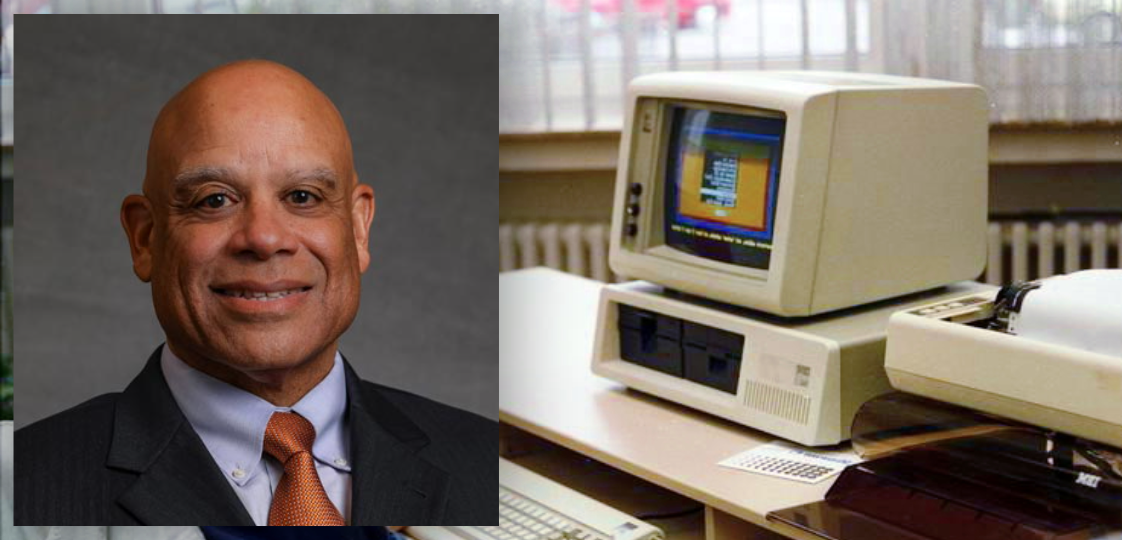Mark E. Dean: co-inventor of the PC
26 October 2020

As part of Black History Month, we are celebrating Mark E. Dean: an inventor, computer scientist, and engineer who has spent his career working to make computers more accessible and powerful. His groundbreaking work has made a lasting impact on the way we use computers today.
“A lot of kids growing up today aren’t told that you can be whatever you want to be. There may be obstacles, but there are no limits.”
Professor Mark E. Dean was born in Jefferson City, Tennessee, on 2 March 1957. From a young age, Dean had an affinity for technology and invention. His father, a dam supervisor at Tennessee Valley Authority, encouraged this interest, and for fun, they built a tractor from scratch. Unsurprisingly, Dean was also an excellent student. One of the few African American students at his high school, Dean was a star athlete and straight-A student. He went on to study electrical engineering at the University of Tennessee, where he graduated in 1979 at the top of his class.
Shortly after graduating, Dean was interviewed by several big technology firms. At his interview for Hewlett-Packard (HP), which included problem solving, he was made a job offer on the spot. Dean eventually decided on IBM (International Business Machines), where he started as an engineer. When he joined the industry, computers were just moving from punch cards to screen-based displays; his first job at IBM was to develop a word processor adapter for IBM’s Datamaster terminal.
This period marked the shift towards the use of personal computers (PCs), which were starting to become popular with consumers, and Dean’s first big invention at IBM played a big part in this. The Industry Standard Architecture (ISA) system bus, a set of wires inside of a computer that allow data to be passed back and forth, was developed by Dean and his colleague Dennis Moeller, and soon became an industry standard. In Dean and Moeller’s new system, you could expand PCs with memory, disk drives, printers, and monitors, by plugging them directly into computers using the new ISA slot. Their work forever changed the usability of the personal computer.
In 1982, at 25, Dean had just completed his masters degree at Florida Atlantic University and was now in charge of PC design at IBM. He led the team that designed the original IBM PC, earning him three of the nine original patents for that device. Ten years after he completed his masters, Dean went back to university to study for a doctorate at Stanford University, which IBM agreed to fund while still paying him his full salary.
In 1999, he made a breakthrough in data processing when he and a team of engineers at IBM created the very first gigahertz chip. Prior to then, computer processors were operating in kilohertz (one thousand cycles per second) and megahertz (one million cycles per second). With Dean’s game-changing piece of technology, computers were able to perform one billion calculations per second. The chip meant that people could process data faster than ever before; it broke the barriers of what manufacturers and engineers thought was possible.
Vision for the future of technology has defined Mark Dean’s career. In an interview with Frank McCoy for the U.S. News & World Report in 1999, Dean spoke about what he thought the future of the personal computer looked like. “Early in the next century, Dean hopes his new concoction, which he says is "in the idea and invention stage," will be ready for the public: a sleek tablet that is magazine-size, inexpensive, programmable, and voice-activated.” Dean's prediction was brought into reality by Apple, who launched the iPad in 2010.
In 1996, Mark Dean was the first African American ever to be named an IBM fellow, and in 1997, he was honoured with the Black Engineer of the Year President's Award, and inducted into the National Inventors Hall of Fame. Just this month, he was made an honorary fellow of the Institute of Engineering and Technology to mark its 150th year. Dean’s work in computing is nothing short of revolutionary.